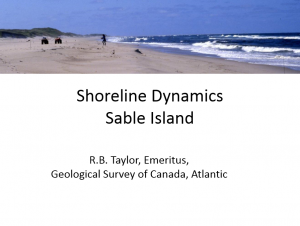Sable Island is one of the longest continuous sand beaches and largest dune systems found in Atlantic Canada yet little has been written about its beach and nearshore dynamics and their relationship to backshore dune stability. Between 1975 and 1985 repetitive cross-shore surveys and depth of disturbance rods were used to measure spatial and temporal variations in sediment transport and beach mobility at a number of sites, particularly where foredune restoration was occurring. Insights from the program are presented including recognition of the diversity of nearshore bar features and the impact of their variability on beach stability; the complexity of beach response to waves on north and south beaches during the same ten day period; and the impact of wave overwash and backshore flooding on foredune rebuilding compared with barrier beaches on mainland Nova Scotia. Mean decadal shoreline recessions of 2 to 6.1 m/a were observed at a few sites along north and south Sable Island; however, short term fluctuations in beach width of 32-48 m can occur in response to nearshore bar dynamics. Daily recordings of beach sediment movement illustrate berm building versus erosion on opposite shores. A natural mechanism of landward barrier beach migration during rising sea level is by wave washover and backshore extension. A different dynamic for sedimentation in dune cuts and long term dune recovery occurs on Sable Island because of increased seawater ponding during storm wave overwash.

